Decorating your living room can be an exciting yet daunting task.
With so many options for furniture, layouts, and styles, it’s hard to know where to begin.
The furniture arrangement is key – it can make or break the whole look and feel of your space.
✨Click to Get My 101 FREE Designer Room Ideas
Cozy Conversation Pit
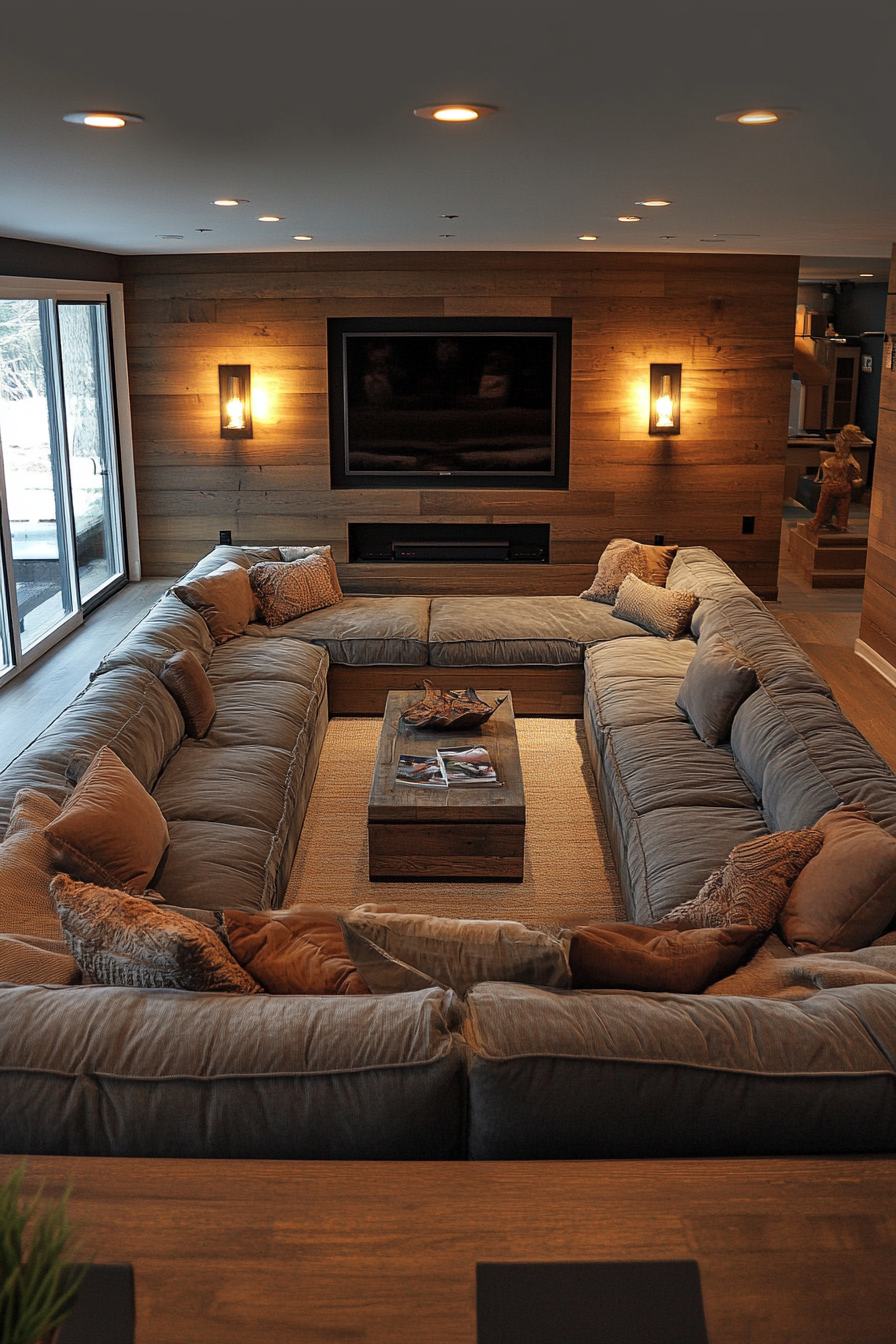
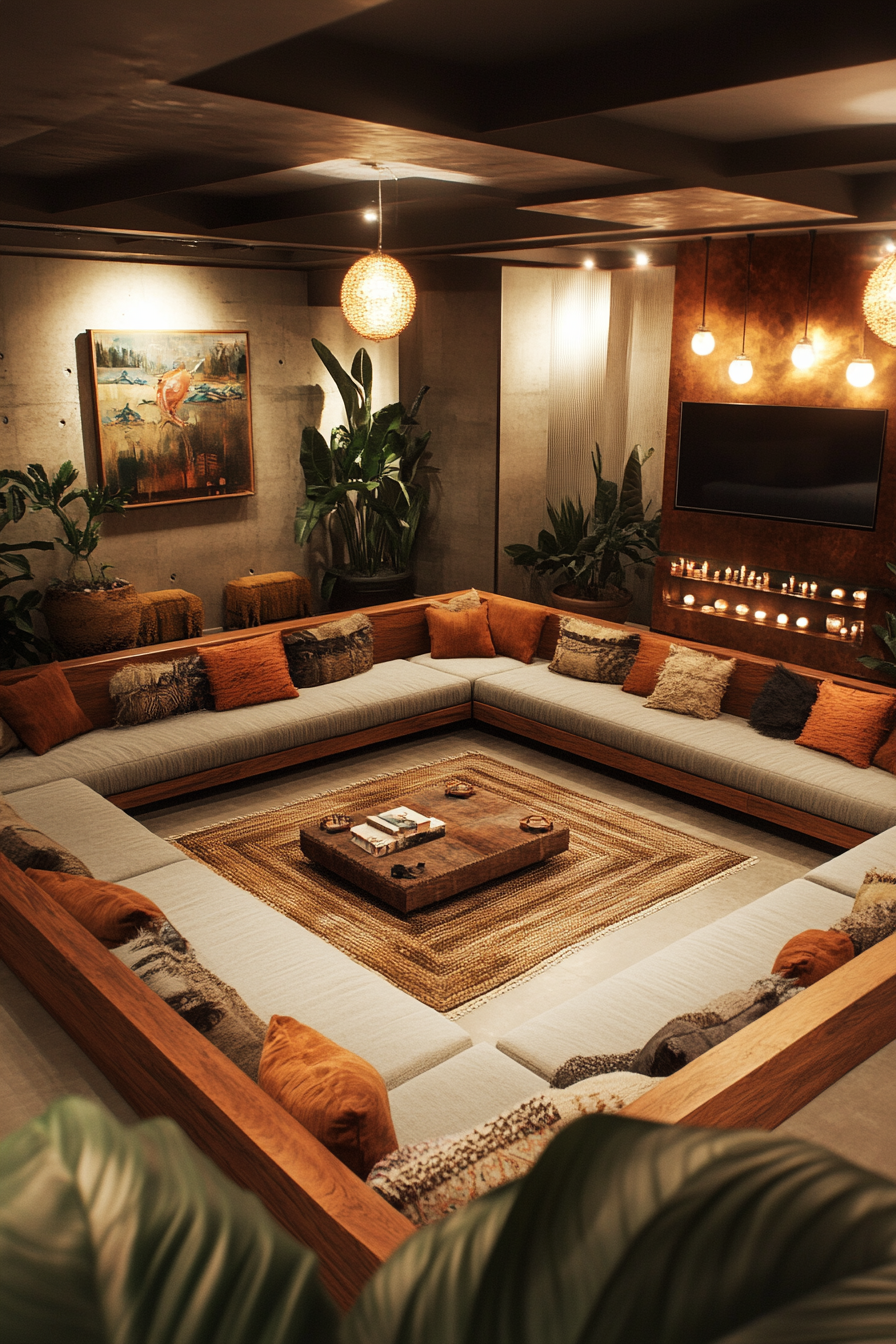
Let’s begin with a warm and intimate arrangement perfect for conversation.
The conversation pit places the seating in a sunken square or circle, with the rest of the furnishings wrapping around it.
This encourages interaction and creates a cozy, cocoon-like feel.
Start by placing your largest sofa or sectional in a U-shape, with the open end facing the focal point of the room, such as the fireplace or TV.
Make sure there is enough space to comfortably fit side tables and lamps next to each end of the sofa.
Place two armchairs across from the sofa facing inward to complete the pit.
Anchor the arrangement by laying down an area rug extending under and around the seating.
In the surrounding space, add accent chairs or benches to provide additional seating when entertaining guests.
You can also fill the gaps with shelving, media cabinets, tables, or even stools for extra seating.
Just be sure to leave enough space for circulation behind and around the pit.
To reinforce the enclosed feel, use coffee tables and ottomans to fill the center space of the pit.
The surfaces can hold books, remotes, and decor.
You could also add a rug here to delineate it.
To balance the low seating, hang wall art or mount the TV higher on the wall above eye level.
Warm, layered lighting is key for this cozy arrangement.
Install floor lamps behind the pit seating to wash the walls in a soft glow.
Table lamps and sconces will provide handy task lighting.
And if your space allows, a pendant or chandelier centered above the conversation area creates wonderful ambiance.
The materials you choose will influence the vibe.
For a relaxed boho look, choose woven, natural textiles and wooden furniture.
Or go dramatic with lush velvets, rich leather, and dark finishes for a glam or moody aesthetic.
Mixing modern and vintage pieces also works beautifully.
Just ensure everything coordinates.
Does a conversation-starting living room sound appealing?
This smart layout is both striking and intimate.
Make the most of your space by bringing people together!
Focal Point Furniture Placement
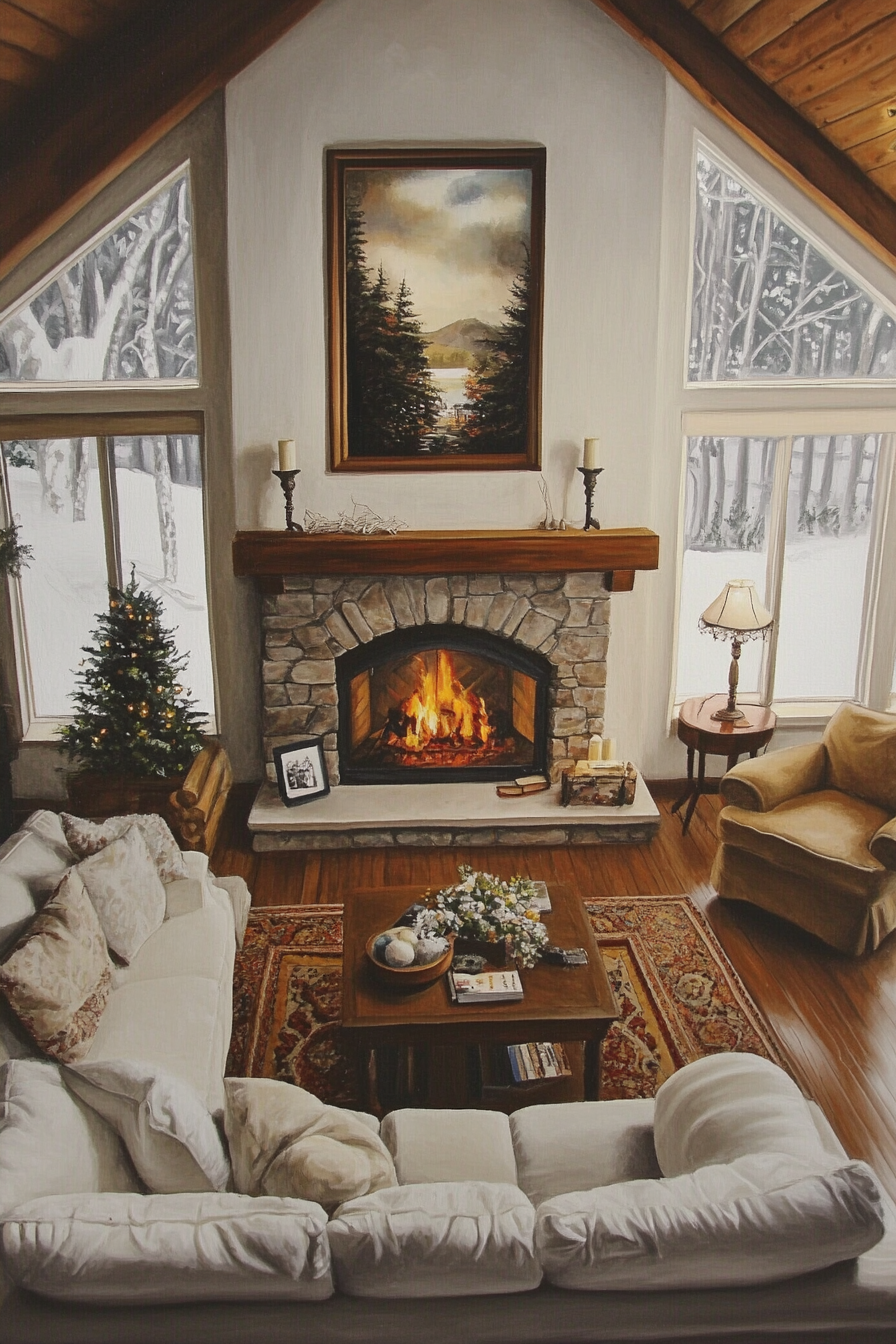
If you want your living room to have a clear focal point, a strategic furniture arrangement is key.
The goal is to direct all attention and traffic toward one area – like the fireplace or a statement piece.
Start by identifying your focal feature.
Will it be the fireplace, entertainment center, a large window with a view, or a striking new furniture piece?
Place this anchor where it will have the most visual impact.
If it’s along a wall, position it at either end rather than dead center.
Next, angle the primary seating like a sofa or sectional toward the focal point.
Make sure to leave enough space between the furniture and anchor to allow for easy circulation.
Chairs, ottomans, and side tables can angle slightly toward the focus as well.
Avoid directly lining up other furniture with the focal feature.
Create a sense of hierarchy by placing secondary pieces – like accent chairs, shelves, and media cabinets – gradually farther from the focal point.
Less substantial items like side tables and lamps go around the room’s periphery.
You want all layers to orbit around your anchor.
Think in triangles when accessorizing to enhance the dynamic feel.
Place pairs of table lamps at angles to one another.
Create vignettes on side tables with decorative objects set diagonally.
Hang wall art offset from the focal point.
Add area rugs that point toward your anchor.
Lighting plays a supporting role in this layout.
Install sconces, picture lights or track lighting to illuminate artwork around the focal feature.
Side table and floor lamps provide task and accent lighting.
Overhead fixtures like a statement chandelier or pendant light will enhance the anchor itself.
The open space surrounding your focal point is prime real estate.
Here you can add a console table behind the sofa for visual interest.
Or float a comfy chair near the anchor to create a secondary conversation nook.
If you have room, define separate zones using area rugs.
For a coordinated look, repeat colors and materials from your focal point throughout the space.
The styles of your secondary furnishings should complement this anchor as well.
Finally, don’t clutter the focal feature or overfill the room.
You want it to truly stand out.
A furniture arrangement with a focal point creates order and visual interest.
Draw the eye effortlessly to an architectural detail, beautiful view or cherished furniture piece.
This smart, nimble layout will make your living room as gorgeous as it is functional.
Sectional Sofa Centered Layout

Nothing says comfort like a plush sectional!
This popular sofa style allows for versatile arrangements perfect for both large and small spaces.
Centering a sectional makes a smart, spacious layout.
Start by placing your sectional facing the living room’s focal point – whether that’s the fireplace, a media console, or mounted TV.
Angle it slightly toward the anchor.
Make sure there’s enough room on either side for end tables, floor lamps and circulation.
Now consider the sectional’s shape.
An L shape is ideal for centering as it has a clear focal side.
Float the chaise end toward an additional focal point like windows.
For a U shape, angle the open end toward the room anchor.
Measure carefully so passageways don’t get blocked.
Build your arrangement outward from the sectional.
Flank each end with matching side chairs or accent tables to create symmetry.
Behind the sofa is the perfect spot for a media console or bookcase.
Just be sure to leave a minimum 2-3 feet for traffic flow.
Use layers of lighting to make the space feel warm and inviting.
Install sconces or pendant lights above the sectional to bathe it in a flattering glow.
Table lamps on end tables provide directed task lighting.
Consider a floor lamp or two behind the sectional for ambiance.
Now for fun details to personalize the layout.
Drape throws and arrange pillows artfully on the sectional for added coziness.
Fill in any negative space with poufs, ottomans or stools.
Hang artwork symmetrically above the sofa, with pieces the same size and distance apart.
To define zones within the open layout, roll out area rugs under and around the sectional.
Place coffee and side tables atop them.
You can angle the rugs toward the focal point rather than centering them.
Add a rug under the sectional and extend it toward the TV or fireplace.
Remember sightlines when selecting sectional shape and placement.
Avoid blocking views out windows, into entryways or toward the focal point.
Leave enough space to comfortably walk around.
Centering your sectional creates symmetry and flow.
It works well in both large loft-like spaces or smaller footprints.
Surround it with functional and decorative touches to design a living room that’s stylish, flexible and functional.
L-Shaped Sectional Layout
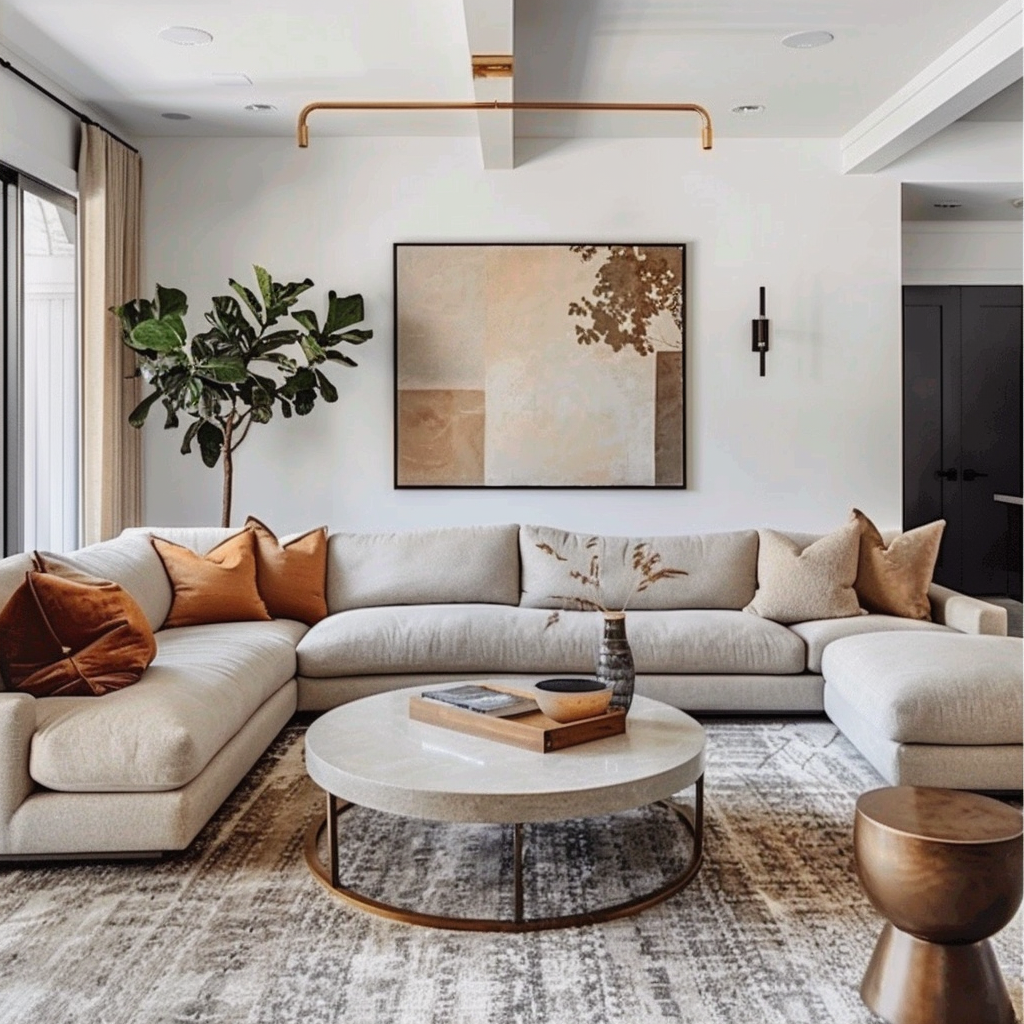
The versatile L-shaped sectional offers comfortable seating while maximizing space.
Arranged properly, it can make small rooms feel more open and expansive.
Let’s explore how to lay out an L sectional like an interior pro.
Start by placing the long side of the sectional against the length of a wall.
Have it face toward the room’s focal point – perhaps a fireplace or large window.
Floating the sectional away from the wall allows for traffic flow behind it.
Now consider sectional orientation.
Facing it toward an open concept kitchen or dining room creates one large communal area.
For more privacy, face it toward a solid wall and place the TV there.
You could also orient it to angle slightly toward a corner focal point.
Be strategic with sectional placement.
If windows or doors are on the adjoining wall, avoid blocking them.
Leave at least 18 inches of clearance.
Allow enough space between the sectional and focal point for easy circulation.
Create flow behind and around.
Make good use of the space behind the sectional.
This is prime real estate for a sofa table, bookcase or media console.
Floating shelves mounted on the wall also work beautifully.
Add floor lamps for ambiance, but take care not to block passageways.
On the open short end of the sectional, place a chair, chaise or ottoman to balance the arrangement.
Nestle side tables in the corner nooks for handy surface space.
Near the TV, angle a cabinet or console to fill the room without crowding.
Light the space evenly with a balance of ambient and task lighting.
Install floating shelves or sconces above the sectional to cast a glow over the seating.
Table lamps provide a focused light for reading nooks.
Use accent lighting on artwork to brighten up the adjoining wall.
Layer in details with carefully arranged accessories.
Drape blankets over chair arms and arrange throw pillows for a cohesive look.
On side tables, create lovely vignettes with books, plants and objet.
Place a large area rug under and around the sectional to define the space.
With smart placement and orientation, the L-shaped sectional can make rooms feel open.
Complete the layout with functional and beautiful touches to create an inviting, multifunctional living space.
✨Click to Get My 101 FREE Designer Room Ideas
Corner Sofa Arrangement

Got an awkward empty corner crying out for purpose?
Enter the corner sofa!
This space-savvy seating solution lets you take advantage of wasted square footage.
Let’s explore how to arrange furnishings around a corner sofa.
Start by placing the corner sofa into (you guessed it) the corner!
Be sure to leave enough room between the wall and sofa for end tables and lamps.
Angle the sofa so both sides face into the room rather than lining it up squarely.
Now consider traffic flow.
If doors or openings are nearby, avoid blocking circulation.
Leave at least 24 inches of clearance on all sides.
You may need to pull the sofa off the wall several inches to allow space to pass behind.
Next, determine the primary focal point.
If it’s the TV, angle the corner sofa to face it head on.
For a fireplace focal point, float the sofa to one side so the entire seating area can view the flames.
Always angle the sofa inward rather than strictly facing the walls.
Build up functionality and visual interest around the perimeter.
Behind the corner sofa is the ideal spot for shelves, a slim media console or cabinet for concealed storage.
A handy side table can tuck right into the corner nook.
Across from the sofa, place two armchairs or a loveseat to form a conversation area.
If space is tight, choose narrow backs and low arms for the chairs.
Nestle a coffee table centrally to complete the seating zone while keeping it intimate.
Take advantage of the corner sofa’s sprawling footprint with handy built-ins.
Floating shelves mounted above provide display space.
Attach sconce lighting to illuminate the sofa and shine down from above.
Removable backrest cushions make cleaning corners easier.
When decorating, layer on lots of luxurious fabrics.
Drape quilts over chair arms and pile on the pillows for ultimate comfort.
Choose a plush rug to anchor the space while adding softness underfoot.
With smart furniture placement and accessorizing, you can create the ultimate cozy lounge in an unused corner.
Follow these tips to make the most of your corner sofa!
Floating Furniture Layout
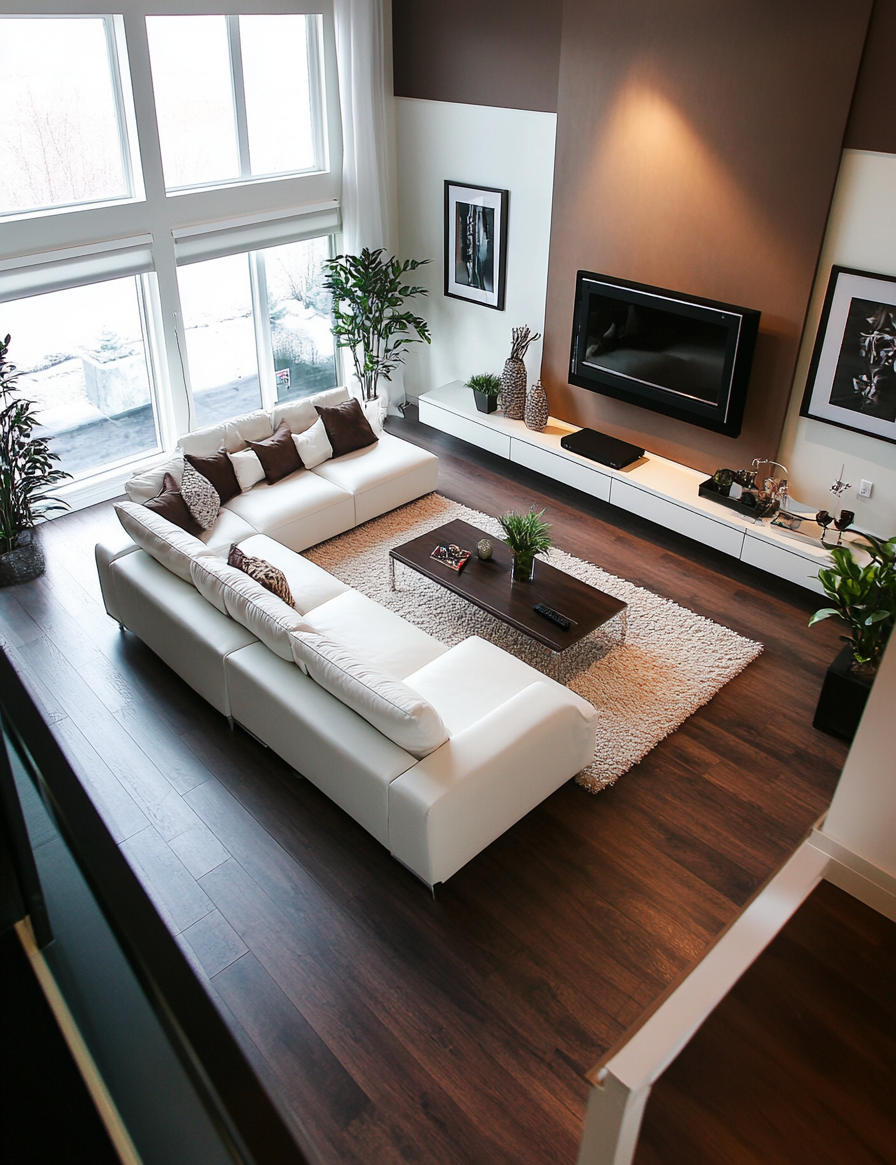
If you long for an airy, open living room, a floating furniture layout is just the ticket.
Rather than pushing pieces against the walls, you “float” furnishings out onto the floor.
This creates free-flowing negative space perfect for movement and conversation.
The first step is moving your sofa or sectional off the wall.
Pull it out at least 12-18 inches.
More space is better to allow traffic behind.
Face the sofa toward the room’s focal point, whether that’s the fireplace, windows or wall-mounted TV.
Flanking the sofa, place a pair of chairs or benches perpendicular to the back cushions.
This invites conversation while keeping the overall footprint compact.
Leave enough space between the sofa and chairs for a pathway.
Behind the sofa, add slim console tables or a media unit centered on the wall.
Floating wall shelves can provide display space as well.
Just be cautious of sightlines if the sofa is very low.
Leave walkways clear.
Now for fun decorative touches to complete the floating feel.
Drape blankets over chair backs and artfully toss pillows onto the sofa.
Prop up framed photos and art against the wall behind the seating.
The clutter-free backdrop helps highlight these objects.
With more exposed floor space, take the opportunity to layer in area rugs.
Place them strategically under each furniture grouping, then use additional runners to connect the spaces.
Rugs help zone and anchor the floaty layout.
Strategic lighting prevents a cavernous look.
Use floor lamps and sconces to wash light over the furniture groupings.
Table lamps provide directional light perfect for reading nooks.
Just avoid brightly illuminating the entire space.
The floating layout allows you to reconfigure furnishings easily to suit changing needs.
With the furniture untethered from walls, you can move pieces around and change up your vignettes seasonally.
If wide open spaces make you feel adrift, try sectioning with screens or curtains.
But take care not to block natural light from windows.
The floating furniture approach maximizes freedom of movement and flexibility!
Square Furniture Placement

For balanced proportions and seamless traffic flow, you can’t beat square furniture placement.
As the name suggests, you arrange pieces in a square or box shape with a focal point at the center.
This symmetric layout provides order in any size living room.
Let’s start with the central anchor.
This can be your coffee table, rug or a conversation seating cluster.
Place the anchor either centered in the room or slightly off center for asymmetrical balance.
Make sure it aligns with the focal point like the TV.
Surround the anchor on all four sides with furnishings.
For example, put the sofa on one side facing the TV.
Perpendicular to the sofa, add side chairs or a loveseat.
This invites conversation while maintaining openness.
On the remaining two sides, place substantial pieces like a media console, bookshelves or cabinetry to ground the layout.
If space is tight, use open etagere-style shelving to continue visual flow.
Leave at least 36 inches between groupings.
Connect the furnishings by layering square or rectangular rugs underneath each component.
Extend the rugs outward from the central anchor slightly, like satellites orbiting a planet.
Overlap where they meet.
Enhance symmetry by repeating design elements in the space.
Choose matching lamps and side tables for each end of the sofa.
Select artwork in like-sized frames to hang above opposite pieces.
The repetition creates pleasing order.
For variety within the balanced layout, introduce other geometric shapes.
Octagonal coffee tables, round ottomans and oval rugs break up the strict lines while complementing the overall square.
Pay close attention to sightlines to avoid cutting anyone off visually.
Ensure views remain clear between anchor points.
Leave enough space for traffic to move freely through the square’s negative spaces.
The tidy, orderly nature of square placement makes it ideal for minimalist decor.
But you can also inject personality with colorful accessories, modern textures or antique finishing touches within the neat framework.
Overall, the square living room layout promotes harmony, flow and connection – with just enough stability.
Gather happily around the central anchor point in this bright, inviting arrangement.
Symmetrical Furniture Placement
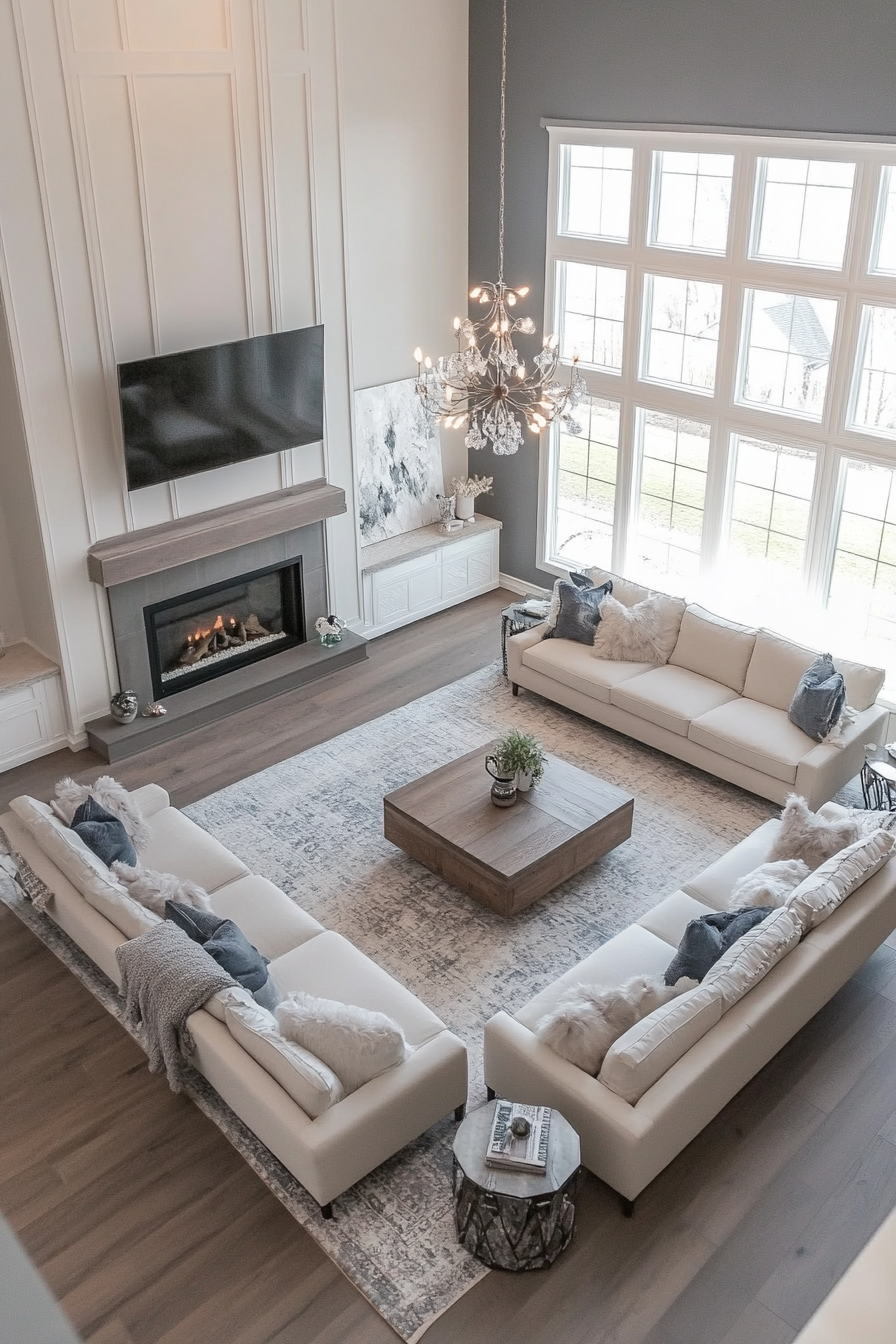
Regal symmetry has power to dramatically elevate a space.
The symmetrical layout uses mirrored repetition on both sides of a central axis to create formal balance.
This impressive technique works beautifully in larger living rooms.
To lay it out, first determine the room’s focal point.
Centre this anchor on a wall or float it slightly off centre along the axis.
Common focal points are the fireplace, large window or media console.
Place the TV here if applicable.
On either side of the focal point, position matching pieces like sofa tables, cabinets or shelving units.
Make sure they are equidistant from the anchor.
The identical pairings should also have the same proportions and style.
At each end of the room, angle the primary seating in toward the focus.
This could be identical sofas or different chairs that are balanced weight and size.
Repeat any paired furnishings like side tables.
Fill the central negative space with a coffee table, ottomans or additional seating.
Layer area rugs underneath to tie the furnishings together while providing a landing spot at the heart of the room.
Enhance symmetry by choosing lighting and decor in matched sets.
For example, place matching table lamps atop the paired end tables.
Hang artwork of like size and scale on opposite walls.
Repeat accent colors or patterns.
Resist the urge to clutter the focal point or make one side busier.
Maintain equal visual weight to preserve the calming symmetry.
You can vary Pillows, throws and objects sparingly to prevent total uniformity.
Guide the eye seamlessly around the room by repeating floor materials along the central axis line.
Hardwood planks or stone tiles running horizontally work beautifully.
Unify smaller rugs.
If your room has multiple entryways, align each doorway with a matched pair of furnishings or lighting.
This welcomes circulation through the thoughtful layout.
Just avoid locating seating directly in front of doorways.
While challenging to perfect, symmetrical furniture placement results in spaces both grand and serene.
The balance satisfies the eyes and mind, creating an oasis of beautiful order in your home.
✨Click to Get My 101 FREE Designer Room Ideas
Feng Shui Furniture Arrangement

Inspired by ancient Chinese wisdom, Feng Shui promotes harmony between interior spaces and those inhabiting them.
Following its placement principles can help any living room feel peaceful, inviting and balanced.
The central Feng Shui rule is thoughtfully arranging furnishings to allow qi (life force energy) to move freely.
Stagnant or blocked qi leads to low moods and cluttered minds.
Here are some beginner tips:
– Face seating toward room entrances to welcome positive energy.
Avoid placing chairs with their backs to doors.
Leave space between furniture and entries.
– Position seating diagonally across from, rather than directly facing, focal points like the fireplace.
This invites gentle interaction.
– Incorporate organic, flowing shapes like oval coffee tables, round rugs and curved lines.
Avoid harsh angles that project aggressive energy.
– Apply the command position rule for optimal authority and protection.
Place the primary seating furthest from and facing the entryway with a clear view.
– Incorporate symbolic Feng Shui enhancements.
Displaying living plants, water features or animal imagery nurtures vital qi energy.
– Use calming colors like light blues, greens and grays.
Earthy, natural textures and materials are preferable to stark metals and synthetics.
– Angle sharp corners of furnishings like shelves away from pathways to avoid cutting or blocking qi movement.
Leave space in areas of high foot traffic.
– Balance yin (calm, passive) and yang (bright, active) zones.
For example, place sofas and beds in dimmer, quieter areas and desks in light, lively spaces.
– Incorporate meaningful artworks, photos and accessories.
Images showing water, gardens, family and positive symbols uplift spirits and qi.
– Address clutter immediately by sorting, organizing and removing unused items.
Disorder cluttering surfaces or blocking movement disturbs qi.
– Allow natural light to flow freely through windows.
Sheer curtains filter and soften daylight while still permitting qi to pass through.
With a basic grasp of Feng Shui principles, you can thoughtfully arrange your living room to nurture positive energy flow.
Mindful tweaks enhance wellbeing for both body and spirit.
Vignette Style Layout
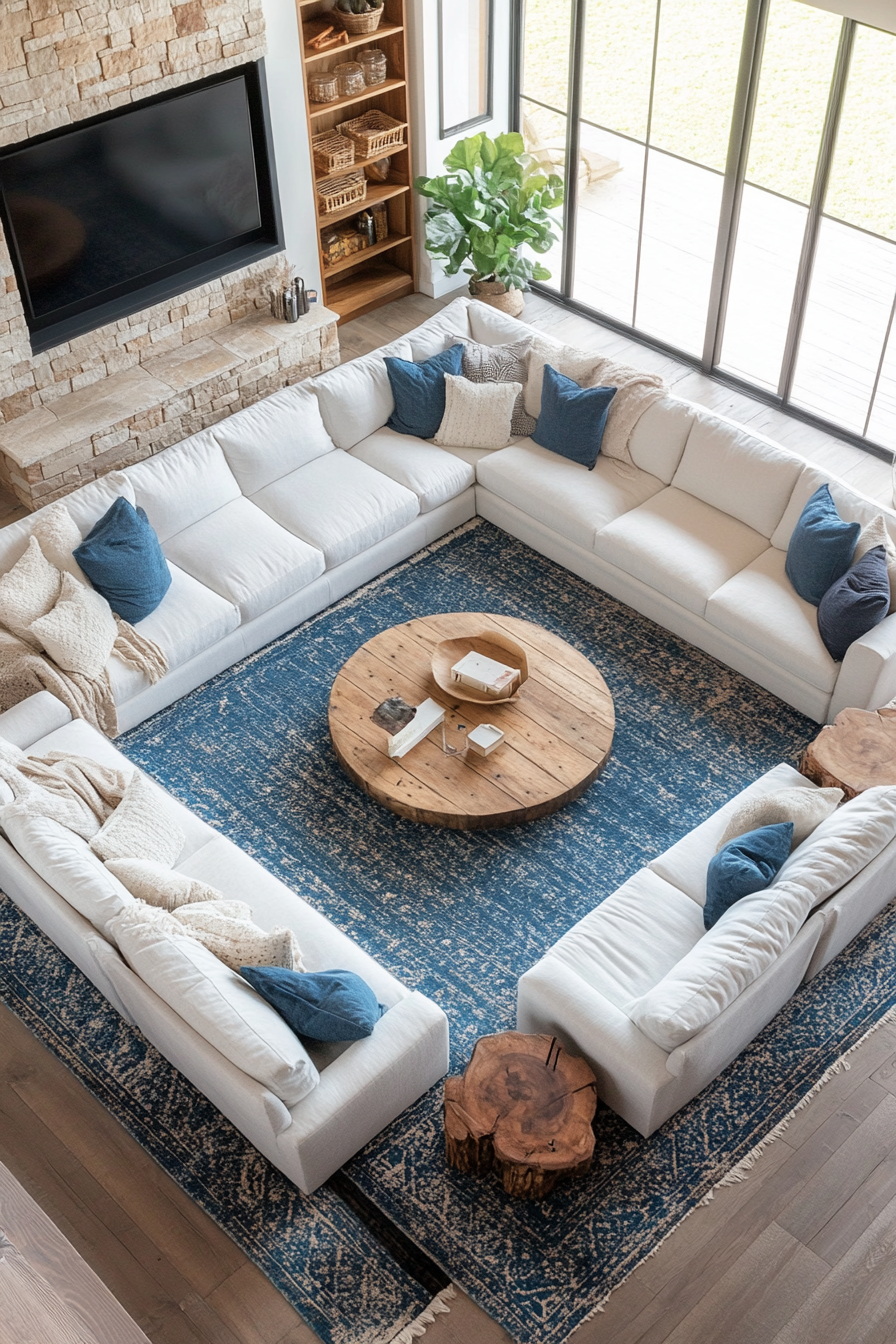
If a scattered, curated look sparks joy for you, try a vignette style living room layout.
This arrangement comprises eclectic furniture groupings, much like captivating scene sets.
The laid-back vibe invites relaxation.
To create vignettes, start by identifying activity zones within the living room.
For watching TV, float the sofa facing the media center.
Near windows, place two chairs overlooking the view for conversation.
Rather than lining up furniture around the perimeter, angle pieces toward the center of each zone.
Complete the scenes by adding a coffee table, side tables, floor lamp or ottoman.
Vary heights and scales between vignettes to maintain visual interest at all sightlines.
Place a dainty slipper chair next to a substantial sofa.
Combine a bench or chaise with chairs boasting tall backs and arms.
Use area rugs to define each space while connecting the overall look.
Scatter a few plush Moroccan rugs rather than one large one.
Overlap them slightly at the edges for a relaxed vibe.
Take advantage of negative space between groupings.
Position a slim bookshelf, console table or floor lamp in the gaps without overcrowding.
Floating wall shelves work beautifully as well.
Embrace eclectic, bohemian decor.
Mix vintage furnishings like a leather club chair or tufted ottoman with modern and antique accents.
Throw in global touches like tribal pillows or a Persian rug.
Create captivating vignettes atop furniture and shelving.
Display stacked books, candles, framed photos, small sculptures, vases and found objects.
Experiment with arranging items in asymmetrical groupings.
Infuse warmth and texture with layers of cozy fabrics.
Drape cashmere throws over chair backs.
Choose velvet, linen and sheepskin upholstery that invites touching.
With moody ambient lighting, you can heighten the intimate vibe.
Use floor lamps to illuminate each seating area.
Install sconces above focal furniture.
Add table lamps for reading nooks.
The vignette living room exudes boho personality.
Curate a space that nourishes your spirit while providing relaxed zones to unwind with family, friends or solo.
Mixed Styles Layout
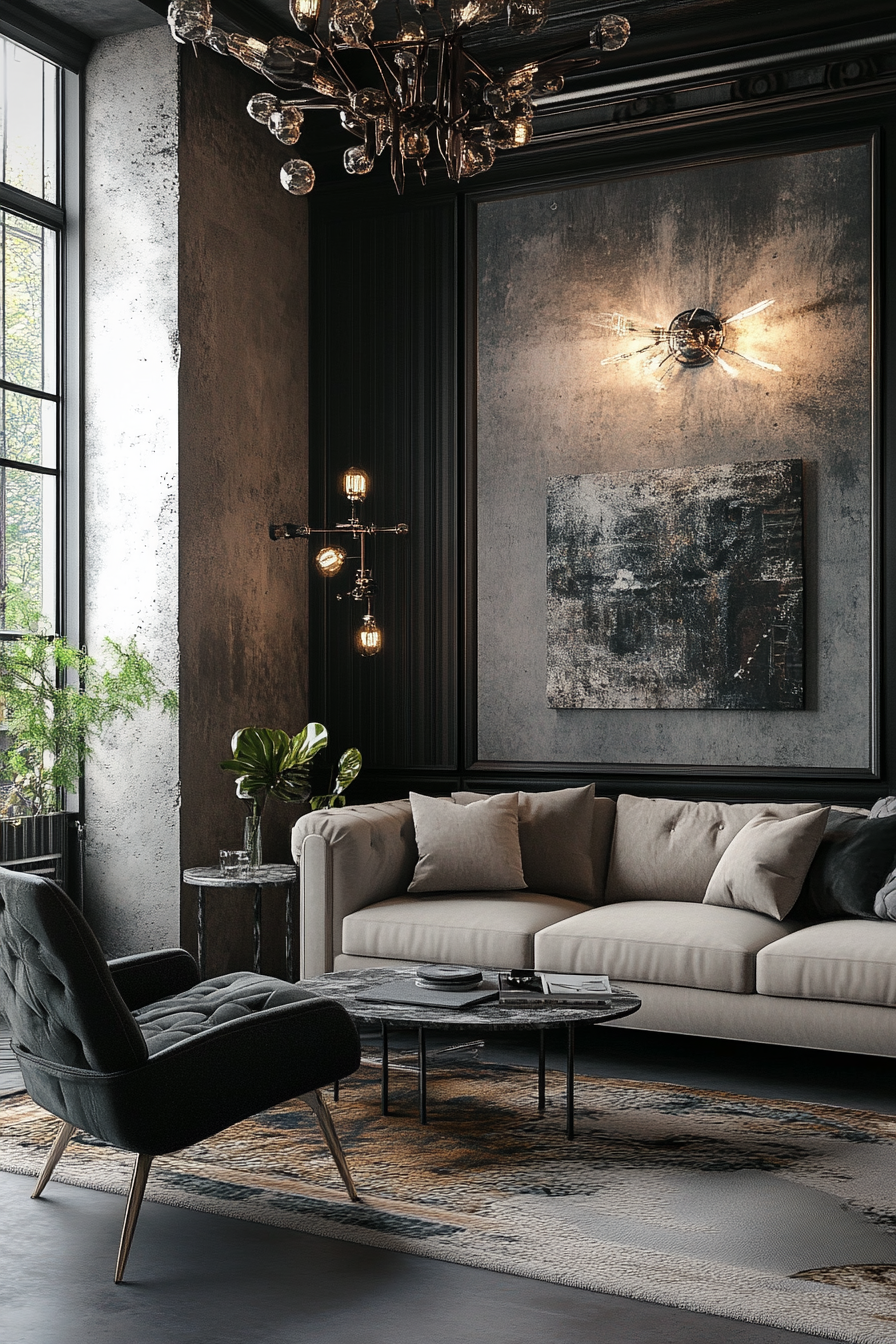

If your taste spans multiple eras and aesthetic directions, embrace it!
Combining furniture and decor from various styles creates eclectic living rooms brimming with personality.
Blend and juxtapose with confidence.
When incorporating multiple styles, maintain cohesion through color palette and materials.
For a moody modern space, stick to a muted neutral scheme of blacks, grays and ecru.
Or go bright and playful with retro primary hues on accessories.
Repeat certain materials such as warm woods, cool metals or tactile textiles to prevent disjointedness.
If introducing many patterns like graphic prints, florals and plaids, keep the color scheme tight.
Strike a balance of vintage and contemporary furnishings.
Pair a contemporary sectional or chairs boasting clean lines with a substantial antique coffee table, accent cabinet or console.
Play with scale for compelling mixed styles vignettes.
Float a petite slipper chair next to an oversized sofa or midcentury recliner for interest.
Top a sleek marble coffee table with stack of design books.
Use lovely layered lighting fixtures to bridge eras.
Install a sputnik chandelier or industrial pendant light above a traditional sofa.
Combine a curvaceous table lamp with rectilinear sconces.
Incorporate beloved hand-me-down furnishings from relatives to infuse personality.
The charm of an heirloom chair or passed-down quilt contrasts beautifully with new items.
Arrange your furnishings asymmetrically rather than spacing identically along a wall.
Float pieces out toward the center, angling some toward focal points.
Define zones with area rugs.
Vary textures when combining periods and motifs.
Juxtapose the nubbiness of a Persian rug, smooth marble surfaces, weathered leather, sleek velvet, and distressed woods.
Most importantly, display your collection of beloved pieces proudly.
A passionately curated space reflecting your interests exudes joyful spirit.
The effect is welcoming and personal.
Shelving Centric Layout

For book lovers, media buffs and curators of collections, a shelving-centric living room is a dream.
The style showcases beautiful built-ins or bookcases as the starring furnishings.
Display your library while keeping the layout airy.
Start by determining the primary focal wall suited to anchor substantial storage.
This may be where the TV is mounted, alongside the fireplace, or a lengthy empty wall begging for purpose.
On the focal wall, arrange open bookcases or shelving units symmetrically.
Float identical pieces equidistant from the room’s center point.
Or place one expansive built-in shelving unit centrally.
Flank the storage with slender furnishings that don’t obstruct sightlines.Low profile sofa or chairs work beautifully.
Glass coffee and side tables also let the stunning shelves shine.
Take advantage of the entire wall vertically.
Install ceiling-height shelving units where possible.
Mix in horizontally oriented cabinets and rectangular units.
Floating ledges and wall-mounted rails can also hold objects.
Organize your displays symmetrically for serene order.
Group book collections by color.
Alternate items of varying heights like stacked novels, vases and framed art.
Repeat shapes and materials.
Illuminate shelving displays artfully with built-in lighting.
Use interior shelf lighting or install track lighting.
Sconces spaced above each unit provide both ambiance and visibility.
Make the shelves multi-functional with hidden storage opportunities.
Try doors that conceal media components or cabinets to house clutter.
Baskets hold objects attractively.
Incorporate specially lit display nooks.
Glass cabinets with internal lighting are perfect for prized collectibles or barware.
Floating shadowbox shelves let you highlight artwork under individual spotlights.
Take time curating vignettes on the shelves by color, subject or material.
Maintain balance without overfilling.
Leave breathing room between groupings.
Matching frames and vessels keep displays crisp.
The shelving-centric living room lets treasured books, objects and media take center stage.
Make the most of vertical space while keeping floors clutter-free.
Showcase collections in beautiful balance.
✨Click to Get My 101 FREE Designer Room Ideas
Seating Centric Layout

Comfort is king.
For living rooms devoted to quality time with loved ones, make seating the star.
A seating centric layout incorporates plentiful chairs, sofas and lounges while minimizing clutter.
Begin by bringing in substantial primary seating like a 3-cushion sofa or spacious sectional.
Place centrally facing the focal point, which may be the fireplace or television.
Leave plenty of room for additional furnishings.
Next, add secondary seating options around the room’s perimeter.
Armchairs, loveseats and chaises create inviting reading nooks and conversation zones.
Avoid pushing them flat to walls.
Convert unused space into additional seats.
Bench seating can replace coffee tables, outfit window alcoves or float next to bookshelves.
Round ottomans offer flexible extra perches.
Take advantage of seats that multitask.
Sofas with storage space conceal clutter discreetly.
Oversized ottomans contain serving trays or hideaway tables for entertaining.
Play with heights and styles.
Pair standard armchairs with a low slung papasan chair.
Mix parsons chairs, curvy accent chairs and loungers.
Vary plush, firm and moulded seats.
Arrange furnishings to facilitate conversation and connection.
Face seats toward one another.
Sectionals with chaise options allow shifting configurations.
Use side tables sparingly to prevent clutter from accumulating.
Raising them on casters makes it easy to move between arrangements as needed.
Incorporate tabletop surfaces into seating for self-contained vignettes.
Nesting and lift-top coffee tables provide ample serving space.
The seating centric layout accommodates both lavish parties and subdued solo time.
Make mornings reading the newspaper or evenings chatting over wine a luxurious experience through smart, clutter-free placement guided by comfort.
Small furniture tweaks like floating pieces off walls or converting underutilized corners can make rooms feel brand new.
Always keep sightlines open and traffic flowing.
Most importantly, embrace your personal style.
Showcase cherished collections in shelving-centric designs.
Invite connection through conversation-friendly furniture arrangements.
Or devote the space to plush, abundant seating for relaxation.
Thoughtfully arranged furnishings improve how we experience our homes.

